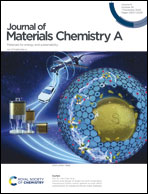Expediting polysulfide catalytic conversion for lithium–sulfur batteries via in situ implanted ultrafine Fe3O4 nanocrystals in carbon nanospheres†
Abstract
The sluggish reaction kinetics and notorious polysulfide shuttling arising from the multistep solid/liquid conversion are the significant obstacles to practical applications of lithium–sulfur (Li–S) batteries. Herein, composites of highly active Fe3O4 electrocatalytic nanocrystals embedded in carbon nanospheres (Fe3O4/CNSs) are introduced into Li–S batteries through separator modification for accelerating polysulfide redox conversion and alleviating polysulfide shuttling. Monodisperse Fe3O4/CNSs with a size of 50–200 nm are prepared for the first time using an anti-solvent induced crystallization process, in which ultrafine Fe3O4 nanocrystals are homogeneously dispersed in the carbon nanosphere framework with a high mass ratio of up to 43.6%. By virtue of Fe3O4 nanocrystals, the kinetics and thermodynamics of multistep polysulfide redox reactions are greatly improved, including improved adsorption interactions, accelerated Li2S6 consumption reactions and a lowered Gibbs energy barrier of Li2S6 to Li2S reactions as confirmed by adsorption experiments, symmetrical cell tests and DFT calculations. In addition, the presence of Fe3O4 can also reduce the energy barrier for initial Li2S nucleation and enhance the kinetics of the subsequent Li2S electrodeposition. As a result, the pure sulfur cathode assisted by chemisorption-catalysis functionalized Fe3O4/CNSs-PP separators could deliver a high reversible specific capacity of 1210 mA h g−1 at 0.2C and an ultralow capacity attenuation of 0.027% per cycle over 1000 cycles at 1C. Even under a high current rate of 5C, the sulfur cathode still maintains a specific capacity of 649 mA h g−1. This feasible approach toward Fe3O4/CNSs will open up alternative pathways for fabricating other ultrafine nanocrystal composites for electrochemical and catalytic applications.



 Please wait while we load your content...
Please wait while we load your content...